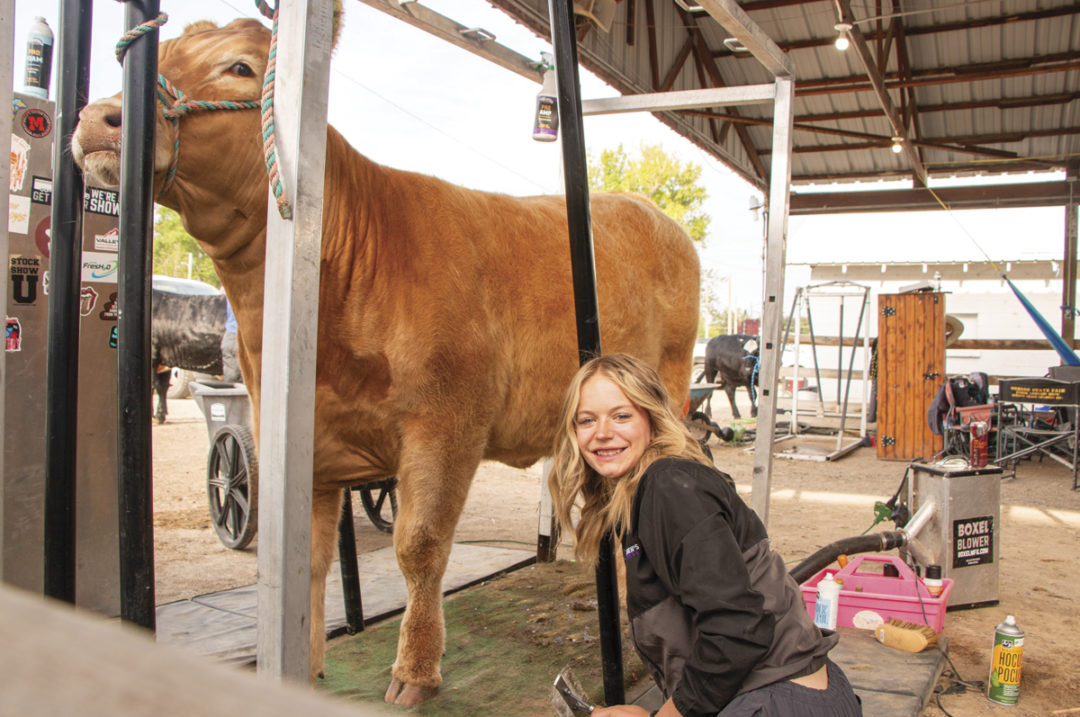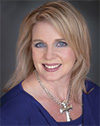Several South Magic Valley District FFA students were interviewed about refining a breeding program in their livestock projects.
“Since entering the world of breeding cattle in 2021, I have had the goal of improving my cattle genetics to suit my needs as well as the needs of the industry around me,” says Kaylee Lierman of Filer FFA. “The purpose behind my cattle line is to provide quality calves to the youth in my area for show or production purposes. I have done this by selecting females with desirable traits and breeding them to bulls that are leading in the industry in hopes of producing functional and good-looking calves. You can't just breed to bulls that are flashy and cool-looking; you need the numbers and data to back them up. I breed my cows with the mindset of enhancing certain traits and correcting any flaws.”

Kaylee Lierman of Filer FFA shows her heifer at numerous cattle shows throughout the state. Photo by Riley Nash.
Kyla Knudson of Castleford FFA with swine projects says, “Buying semen, learning to A.I., proper feeding and farrowing dates has allowed a better outcome in litters. My dad purchased better breeding stock so we could continue the process from beginning to end to achieve better results.”
“Our ladies/sows get looked over thoroughly, and then the dad/boar are chosen to help improve the faults of the sows by correcting them through good breeding genetics. We look at the program from before conception and then to market standards, and judges’ recommendations to improve and make adjustments into the following season. With the three sows we have, we usually have great options for choosing our market hog choices,” says her brother Ian Knudson.

Kyla Knudson breeds and shows swine as FFA market projects. Photo by Lisa Knudson.
“As livestock producers, we have many options when it comes to improving genetics in our herd,” says Connor Porath of Kimberly FFA, with beef projects. “I have taken advantage of a couple options in my herd. My biggest move was purchasing higher-end genetics from local production sales in order to incorporate new genetics. On top of this, I have kept back replacement heifers which I artificially inseminate with semen purchased from a variety of higher-end producers. Every year, I am always looking at different bulls and replacement heifers in order to continue to improve my herd. On top of incorporating new genetics, I have also introduced different breeds into my operation, focusing on areas such as muscle and growth.”

Ian Knudson breeds and shows swine as FFA market projects. Photo by Lisa Knudson.
“My FFA breeding herd consists of three registered black Angus cows and two Maintainer (Maine-Anjou cross) heifers,” says Kellyn Jaynes of Castleford FFA. “When I first started out, I bought Angus heifers because my main goal was to have a commercial herd that I could get a calf crop out of every year to sell.”
“A few years back, I decided I wanted to start raising my own show calves. This meant I was going to have to branch off the Angus route and venture into the club-calf route. This has taught me a lot about genetics in the industry and what can go wrong and what can work,” Jaynes says.
She says, “The main thing I have focused on is something my mentor Meghan Nelson taught me: Always keep genetics 50 percent purebred.”

Connor Porath raised and showed the 2021 Twin Falls County Fair Grand Champion Market Steer. Photo by Marni Porath.
“A huge problem that has arisen lately in the cattle industry is inbreeding within the club-calf stock,” says Jaynes. “This causes structural flaws, health problems and a shorter lifespan than, say, an Angus cow. So the rule of thumb for me is: Always breed back to a pure breed. For example, I have a heifer who is a registered Maintainer, but she has a ton of different bloodlines in her and she isn’t more than 25 percent of any breed. I bred her to a purebred Maine-Anjou bull named Peace of Mind. This way, her calf crop will be 50 percent Maine-Anjou.”
“Another route I have been exploring more recently is embryo transplant. Embryo transplant (ET) is the process of taking an embryo out of a desired cow and inseminating the embryo, which is then transferred into another cow. This lets one desired cow and bull pairing have more than one calf a year,” Jaynes says. “The downfall to ET is that it only has a 65 percent success rate, so a calf is not always guaranteed. To combat this, I use a cleanup bull every year that stays with all the cows and heifers for two heat cycles, ensuring that if a cow does not respond to A.I. or ET, they will get bred by the cleanup bull, providing a calf from every cow.”


.jpg?t=1687979285&width=640)



